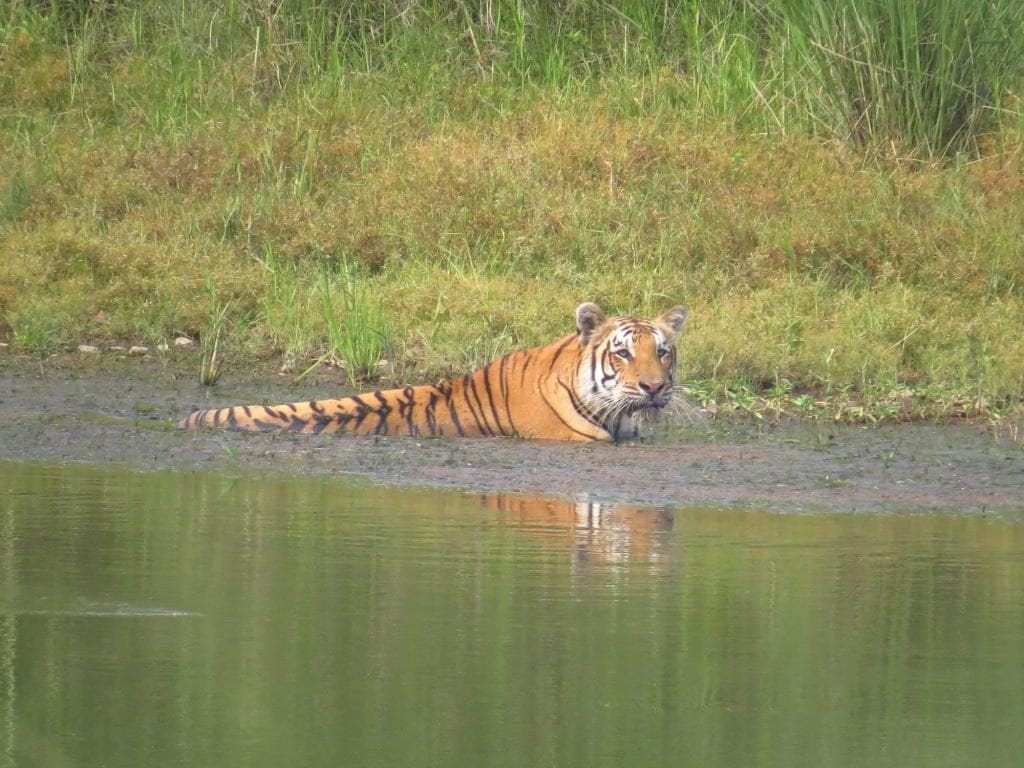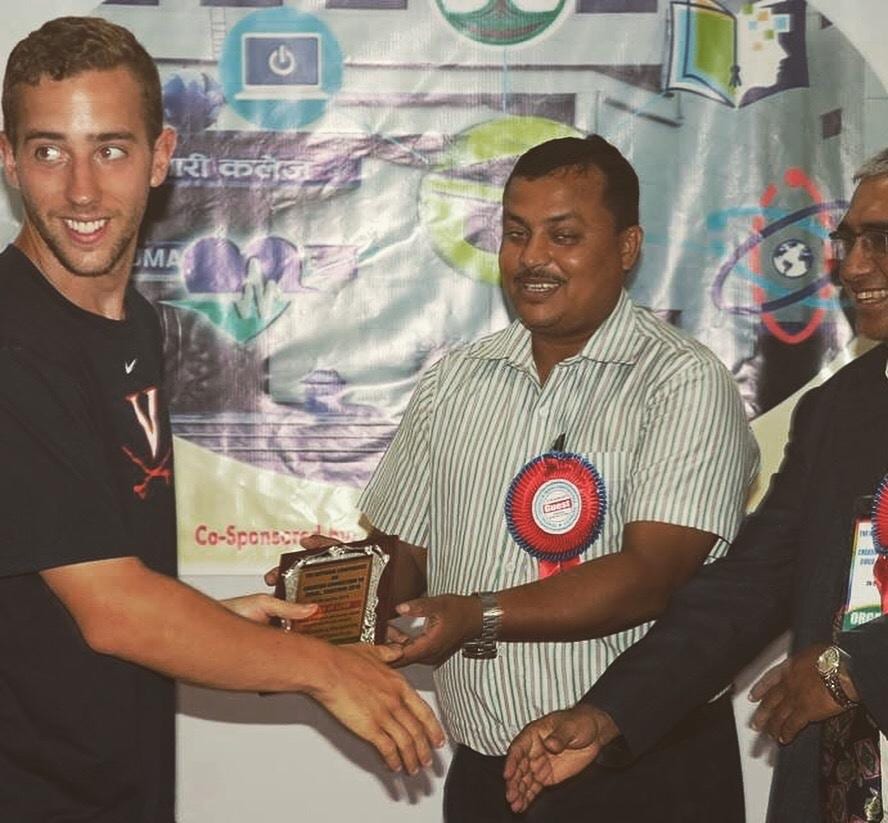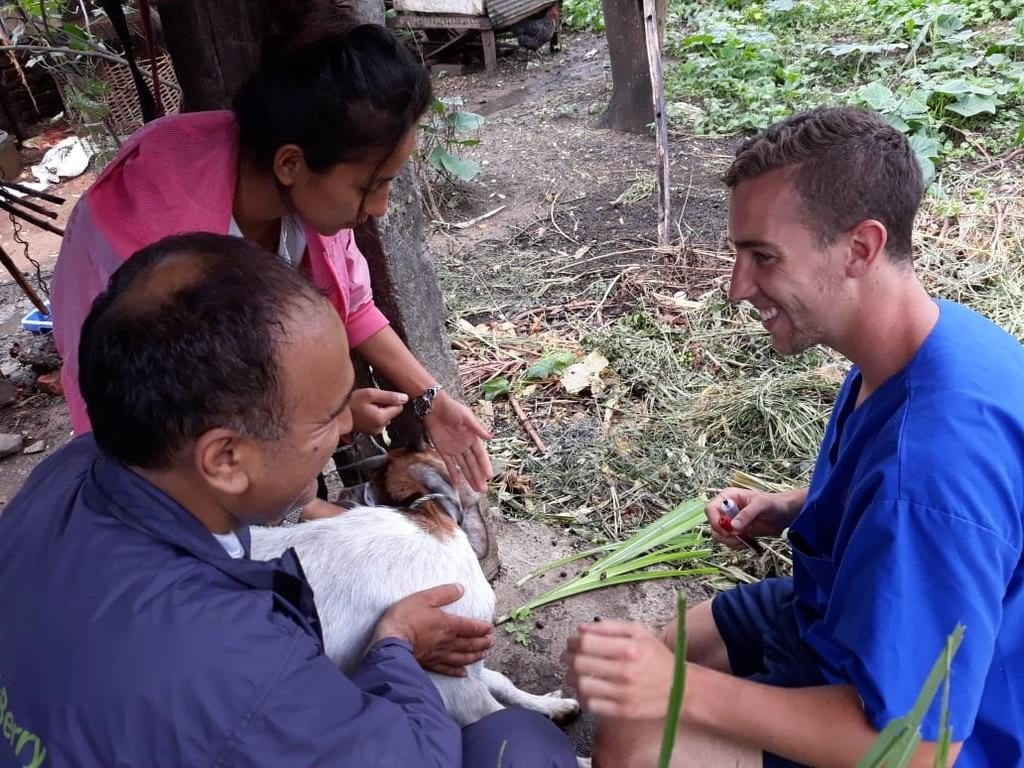Gazing up through the foliage for the source of the growing sound, we find a group of Rhesus macaques, all seemingly distressed and aware of a presence in the jungle unknown to us. Suddenly, the reason for the commotion becomes starkly apparent. A full grown leopard darts down from its post in a nearby tree, swiftly landing on the jungle floor; it flees the scene in a matter of seconds. With our judgment slightly impaired from the recent spike in adrenaline and euphoria, we approach the tree to get a closer look. This movement spooks yet another leopard who races off on the same path. Unable to find our words, my guides and I exchange hugs and high fives in response to the amazing encounter we just experienced. This was thirty minutes into a four day trek of Chitwan National Park, Nepal.

Wild Bengal tiger spotted at a watering hole in Chitwan National Park.
I considered myself inordinately lucky to have spotted such rare wildlife on my first day. While this is true, Chitwan National Park is a haven of biodiversity, and offers one of the best opportunities in the world to see magnificent macrofauna, such as wild Bengal Tigers, Leopards, and Indian Rhinoceroses to name a few. Not only do these animals reside in the park, but they are flourishing and growing in number. In fact, the park has had to acquire more land to accommodate their growing tiger population, which was recently measured at 235 individuals. The success of the park in their anti-poaching regime represents an exemplary story in conservation. It stems from a partnership between the government, local communities and NGOs. Much of the forests bordering the parks have been granted to the surrounding communities, where the members act as rangers and stewards of their land. In concert with local villages, army presence throughout the park has also proven to be immensely effective in mitigating poaching. The park service deservedly boasts that they have been poaching free of tigers and rhinos since 2011.
Despite these incredible gains, the health of wildlife in this region of southern Nepal is not entirely secure. Most notably, transmission of pathogens from domestic livestock to wildlife has proven particularly insidious. Rhinos and elephants have been confirmed dead from tuberculosis, and canine distemper virus remains a looming threat for large cats. With growing human and livestock populations in the buffer zone villages, the threat to wildlife is increasingly imminent. This is why I did my Expanding Horizons Project here.
The focus of my research was to uncover the prevalence of Peste des Petits Ruminants Virus (PPRV) in domestic goat herds of five villages bordering the national park, and from this data, try and make connections between livestock health and risk of transmission to wildlife. PPRV is a disease of immense global importance, and is responsible for $2.1 billion USD in economic losses each year. In Africa, the Middle East and Asia, small holder farmers are often left to bear the brunt of the effects, since their livelihoods are inextricably linked to the health of their livestock.

Receiving the classic Nepali award (Token of Love) after presenting my research at the local Veterinary School.
Through the invaluable aid of my Nepali partners, I was able to sample 218 domestic goats from 64 different households across five villages. For each household, we also conducted a questionnaire to gain information on husbandry, grazing patterns, and previous clinical signs. By pairing this data with the ELISA results from the goat serum, I was able to gather a much clearer picture of the local farming practices and risk factors for PPRV. The most interesting finding from my work was the link between grazing practices and PPRV prevalence. For villages that communaly grazed, where individuals would take their animals to one or two locations in the forest or national park, PPRV rates showed 38%. However, villages that practiced isolated grazing, in which they would cut grass from the jungle and feed their goats on their property, had a prevalence of 18%. While there is inherently a level of error in my data due to imperfect sampling conditions, bias, and a relatively low sample number, this still remains a striking connection.
My time spent in Nepal was undoubtedly my most edifying experience to date. Not only did I get the opportunity to craft and execute a project in a field of veterinary medicine that I’m deeply passionate about, but I was also able to immerse myself in Nepali culture. All of my partners were local Nepali from the Chitwan region, and as a result, I gained practice in partnership and collaboration in an entirely different cultural context.
I returned from Nepal exhausted, but deeply moved, and with a clearer sense of direction and values. I am fervently committed to continue developing my skills, so that I can effectively promote wildlife health and conservation.
Born and raised in the beautiful rollings hills outside Charlottesville, Virginia, Daniel Foley (class of 2021) attended UVA for his undergraduate. He was drawn to the Cornell College of Veterinary Medicine by the university’s opportunities and education in Wildlife Health and Conservation Medicine. He is particularly passionate about conservation efforts in the interface between livestock and wildlife, and how such issues impact human health and the management of ecosystem resources.


